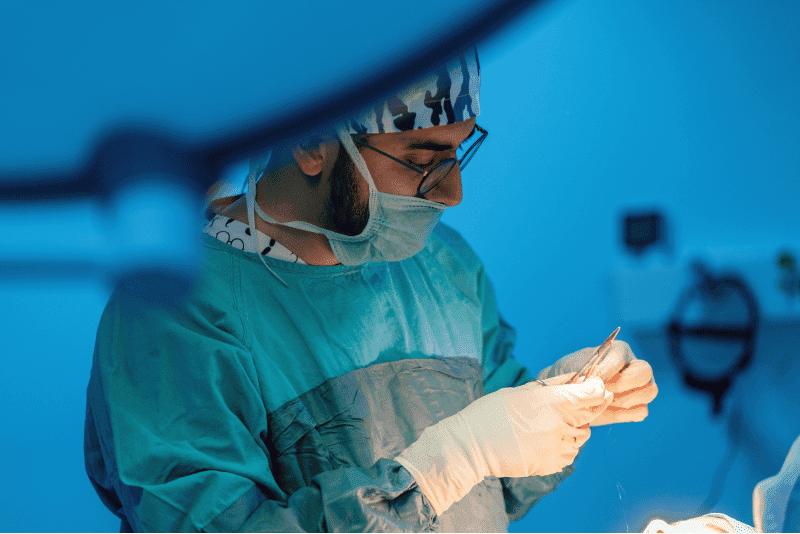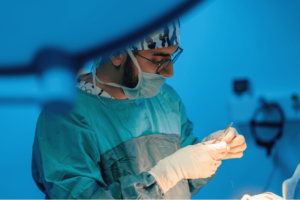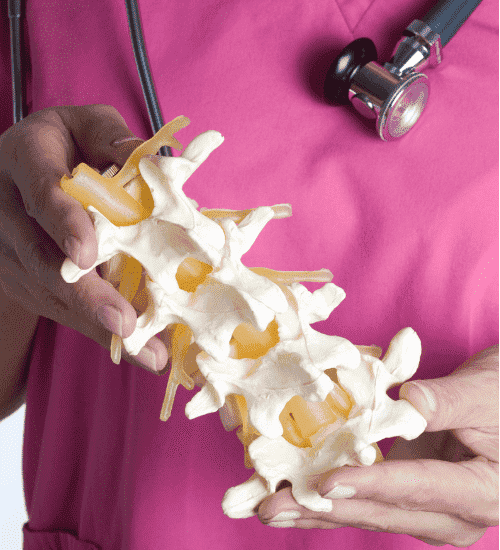- (213) 369-4583
- Monday - Friday
- 9 am - 5 pm
Spinal Fusion Los Angeles

Jun 02, 2022

Back pain is a common ailment that many of us have experienced at some point in our lives. In most cases, it can be effectively managed using a combination of over-the-counter or prescription medications, physical therapies such as chiropractic treatments, and lifestyle changes such as exercise and proper posture. However, there are instances where back pain is caused by an injury or degeneration of the spine, and in these cases, surgical intervention may be necessary to address the underlying issue and provide relief. Since you have searched for Spinal Fusion Los Angeles, it means you also find yourself in the similar situation.
Spinal Fusion Los Angeles: See Dr. Moksha Ranasinghe
If you happen to be in Los Angeles and need a second opinion on getting Spinal Fusion surgery, you can see Dr. Ranasinghe at Southern California Brain & Spine Surgery. We have been treating patients with spine disorders for a decade and are recognized as the most reliable spine care facility for Spinal Fusion in Los Angeles. You can schedule an appointment with our spine surgeon by filling out the contact form or giving us a call at (213) 369-4583.
Spinal Fusion is a surgical procedure that involves the fusion of two or more vertebrae in the spine. This procedure is usually recommended for individuals suffering from chronic back pain caused by conditions such as degenerative disc disease, scoliosis, herniated disc, spondylolisthesis and trauma-related injuries. The objective of the surgery is to provide pain relief and improve the stability of the spine by preventing movement between the fused vertebrae. The decision to proceed with the surgery is made after a thorough evaluation of the patient's condition including physical examination, imaging studies, and a review of the patient's medical history.
Who Qualifies for Spinal Fusion Surgery?
People experiencing chronic back pain that last more than a month are normally considered for surgical treatments. However, your doctor will only recommend a Spinal Fusion surgery once he/she has diagnosed the source of pain. Diagnosis is conducted using scans like MRI and CT.
Given below are some of the common medical conditions that are treated with Spinal Fusion surgery;
- Degenerative Disc - Our spine has rubbery cushions (known as discs) in between the bones to safeguard us from external jerks and injuries. These discs can degenerate over time, however, an early degeneration can also happen due to an injury.
- Scoliosis - It refers to a condition in which a person's spine is curved abnormally. It is more common in adolescents and teenagers.
- Stabilizing Spine - People who have an unstable spine due to any medical reason are recommended Spinal Fusion.
Types of Spinal Fusion
There are different kinds of Spinal Fusion surgeries that are performed by surgeons. Factors like the severity of the damage, location of damage, patient’s overall health condition, age, etc. are considered when deciding which method to follow. Generally, Spinal Fusion is classified into two types of procedures;
- Anterior Fusion - In the Anterior approach, the surgeon reaches the infected area from the font. It means if the surgery is to be performed on the neck, the incision will be made in front of the neck (Cervical Fusion) and if the surgery is to be performed on the lower back, the incision is in the lower abdomen (Lumbar Fusion).
- Posterior Fusion - If the doctor decides to approach the infected area directly from the back, it is referred to as posterior fusion.
Procedure

The patient is given anesthesia before the surgery to make the process less painful. The patient is also advised not to drink or eat anything 6-8 hours before the surgery. Given below is a brief procedure on how the surgery is carried out.
Incision
The surgeon will start the operation by making an incision to gain access to the damaged part. It can be done with any of the approaches mentioned above. The length of the incision for conventional spinal fusion surgery can vary depending on the number of vertebrae being fused together.
- For a single-level spinal fusion, the incision is typically smaller and can range from 2-3 inches (5-8 cm) in length.
- For a two-level spinal fusion, the incision can range from 3-4 inches (8-10 cm) in length.
- For a multi-level spinal fusion, the incision can range from 4-6 inches (10-15 cm) in length.
It's important to note that these measurements are approximate and the actual size of the incision can vary depending on the individual case, the surgeon and the type of surgery. Additionally, in some cases, the surgery may involve more than one incision, depending on the extent of the procedure.
Getting Bone Graft
All kinds of spinal fusion surgeries require some kind of bone material to make the fusion possible known as Bone Graft. The bone can be taken from any part of the body or the bone bank. In case it is decided that the bone will be taken from the patient’s body, the surgeon get it from the pelvic bone by making a small incision and then closing it afterward.
Bone Graft Fusion
The bone is then placed between the vertebrae where fusion is required. Generally, metal plates and rods are used to ensure that vertebrae keep in position while the bone heals. Sometimes, the doctor might also use some substances to expedite the bone growth and healing process.
Risks Involved in Spinal Fusion
Just like any other surgical procedure, Spinal Fusion also carries some risks that could lead to complications. Given below are some of the surgery risks that might occur due to a Spinal Fusion surgery.
- Excessive Bleeding - Minor bleeding is common in surgical procedures. However, If it is a multilevel fusion surgery, there are chances of occurrence of excessive bleeding. Damage to a major blood vessel can also cause excessive blood loss.
- Infection - Soon after the surgery is over, the doctor will give you antibiotics to prevent any infection. However, in some cases, an infection might develop near the incision that can go deeper if left untreated
- Failure to eliminate Pain - It happens when Spinal Fusion surgery does not go right. It fails to eliminate the pain leaving the patient to go through another surgical procedure.
- Dural Damage - Dura is the outermost layer of the three layers that protect the brain and spine. If damage occurs to Dura during surgery, it can cause spinal fluid to leak. Subsequent surgeries are required to repair it.
- Bone Grafting going Wrong - There are chances that the bone used for fusion does not heal and thus fails to fuse the vertebrae. Moreover, if the material that is to be used for the bone graft catches bacteria, the graft fails.
Post-operative Care

The success of Spinal Fusion surgery highly depends upon post-operative care. Following are some of the guidelines to be followed to ensure that the healing period goes right;
- Regular Check-ups - Seeing your doctor regularly is very important to identify any potential complications as early as possible.
- Exercise - Do the exercises recommended by a physiotherapist for a smooth recovery from surgery.
- Incision Care - Keep the incision dry for at least two days after the surgery. Do not cover it unless advised by the doctor. Be careful while bathing, sleeping, and moving around to not to put stress on your back.
- Medication - Only take the prescribed medication by your doctor during the healing process. The doctor will recommend some painkillers to relieve pain and antibiotics to safeguard you from infections.
You can read our in-depth article on recovery after Spinal Fusion surgery here: Road to recovery from spinal fusion
Minimally Invasive Spinal Fusion
Spinal fusion can also be performed using minimally invasive techniques, which involve making smaller incisions and using specialized instruments to access the spine. In minimally invasive spinal fusion, the surgeon uses a combination of these techniques to access the spine and perform the procedure.
- Percutaneous techniques: These techniques involve making small incisions and using specialized instruments to access the spine through the skin. This can include the use of special tubes called cannulas to guide the instruments and allow the surgeon to access the spine without having to make a large incision.
- Endoscopic techniques: These techniques involve using a small camera called an endoscope to view the spine through a small incision. The surgeon can then use specialized instruments to access the spine and perform the fusion.
- Microscopic techniques: Thes techniques involve using a microscope to view the spine and perform the surgery. This allows for a more precise and delicate procedure.
- Robotic techniques: Thes techniques involve the use of robotic arms guided by a surgeon to perform the fusion.
Minimally invasive techniques have many potential benefits compared to traditional open surgery, such as smaller incisions, less blood loss, and a faster recovery time. However, not all surgeries can be carried out using minimally invasive techniques, and the surgeon will carefully evaluate each individual case to determine the best approach.
Consult Dr. Moksha Ranasinghe for Spinal Fusion Surgery
If you happen to be in Los Angeles and need a second opinion on getting Spinal Fusion surgery, you can see Dr. Ranasinghe at Southern California Brain & Spine Surgery. We have been treating patients with spine disorders for a decade and are recognized as the most reliable spine care facility in Los Angeles. You can schedule an appointment with our spine surgeon by filling out the contact form or giving us a call at (213) 369-4583.
FAQs on Spinal Fusion Surgery
When can I travel after Spinal Fusion Surgery?
Typically, patients are able to travel again after their second follow-up appointment, which is usually scheduled 6-8 weeks post-surgery. However, individuals who have encountered any complications during this period may be advised to delay travel. Additionally, it's important to note that heavy lifting and carrying heavy bags should be avoided as it may cause discomfort or strain on the affected area.
How long is the recovery time?
Recovery time after spinal fusion surgery can vary depending on the individual and the specific type of surgery that was performed. It is important to follow your surgeon's post-operative instructions and any physical therapy or rehabilitation plans. Typically, patients are advised to avoid strenuous activity and heavy lifting for at least six weeks after surgery. It's common to need a few months before resuming normal activities.
Will I be in pain after the surgery?
Some pain and discomfort is normal after spinal fusion surgery, and your surgeon will advise you how you can manage it. Mostly, it involves taking over-the-counter pain-killers, physical therapies, and light exercises.
Why do I feel pain in my leg and buttock after spinal fusion surgery?
To experience some pain in lower limbs is quite normal after spinal fusion surgery. It should not be as severe as it was before the surgery and must go away within 3-4 weeks. If that’s not the case, it is recommended that you see your doctor and get examined.


